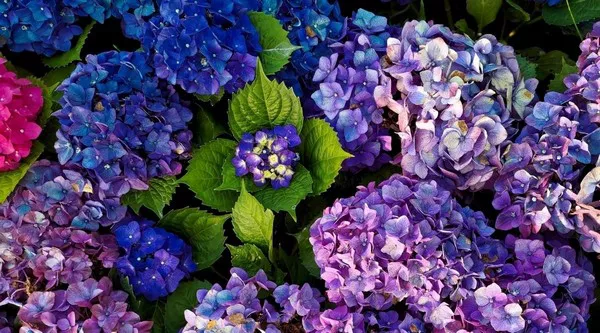Hydrangeas are renowned for their stunning, vibrant blooms that add a touch of elegance to any garden. However, even the most meticulous gardeners may find themselves perplexed when their hydrangea flowers begin to turn brown. While this can be disheartening, fear not—there are various reasons for this phenomenon, and with the right care, you can revive the beauty of your hydrangea blooms. In this comprehensive guide, we will explore the potential causes of browning hydrangea flowers and provide practical solutions to ensure your garden remains a haven of thriving, colorful hydrangea blossoms.
Understanding the Causes of Browning Hydrangea Flowers
1. Watering Woes:
One of the primary reasons hydrangea flowers turn brown is improper watering. Hydrangeas are particularly sensitive to water stress, and both overwatering and underwatering can lead to browning blooms. Inconsistent moisture levels in the soil can cause stress to the plant, resulting in the discoloration of flowers.
2. Sunlight Exposure:
Hydrangeas thrive in partial shade, and excessive exposure to direct sunlight can contribute to browning flowers. If your hydrangeas are planted in an area with intense sunlight, it might be time to consider relocating them to a spot with dappled or filtered sunlight.
3. Soil pH Imbalance:
The pH level of the soil plays a crucial role in the health of hydrangeas. These plants exhibit a fascinating color-changing ability based on soil pH. However, an extreme pH imbalance can lead to nutrient deficiencies, impacting the overall health of the plant and causing browning of the flowers.
4.Nutrient Deficiencies:
Hydrangeas require specific nutrients, such as phosphorus, potassium, and iron, for optimal growth and bloom color. A deficiency in any of these essential nutrients can result in faded or brown flowers. Regular soil testing and appropriate fertilization can help address this issue.
5. Disease and Pests:
Hydrangeas are susceptible to various diseases and pests that can cause browning of flowers. Keep a vigilant eye for signs of fungal infections, such as powdery mildew, or insect infestations. Timely intervention with suitable treatments can prevent further damage.
Practical Solutions for Brown Hydrangea Blooms
1.Adjusting Watering Practices:
Achieving the right balance in watering is crucial for hydrangeas. Ensure the soil is consistently moist but not waterlogged. Consider mulching around the base of the plant to retain moisture and prevent soil dehydration during hot spells. Irrigate in the morning to allow excess moisture to evaporate and reduce the risk of fungal issues.
2. Optimizing Sunlight Exposure:
Evaluate the current placement of your hydrangea bushes. If they are receiving too much direct sunlight, consider transplanting them to a location with filtered sunlight or partial shade. This adjustment can help prevent sunscald and minimize the risk of browning flowers.
3. Addressing Soil pH:
Test the pH of the soil in which your hydrangeas are planted. Depending on the desired bloom color (blue or pink), you may need to adjust the pH. Add aluminum sulfate for more acidic soil (lower pH) and lime for more alkaline soil (higher pH). Regular monitoring and adjustments can promote healthier, more vibrant blooms.
4. Nutrient-Rich Fertilization:
Feed your hydrangeas with a balanced fertilizer that includes phosphorus, potassium, and iron. Follow the recommended application rates to avoid over-fertilization, which can lead to its own set of problems. A well-fed hydrangea is better equipped to produce lush, colorful flowers.
5. Disease and Pest Management:
Conduct regular inspections of your hydrangea plants for signs of diseases or pests. Prune away any affected or dead parts, and treat the plant with suitable fungicides or insecticides as needed. Providing adequate spacing between plants can also improve air circulation, reducing the risk of fungal infections.
Long-Term Hydrangea Care for Blooming Success
1. Pruning Techniques:
Pruning is a vital aspect of hydrangea care, and employing the correct pruning techniques can enhance blooming. Different hydrangea varieties may require varied pruning approaches, so familiarize yourself with the specific needs of your hydrangea type. Remove dead or damaged wood regularly to encourage new growth and prevent browning.
2. Mulching Matters:
Apply a layer of organic mulch around the base of your hydrangea bushes to regulate soil temperature and retain moisture. Mulching not only aids in preventing water stress but also inhibits weed growth, providing a clean and well-maintained appearance to your garden.
3. Consistent Care Throughout Seasons:
Hydrangeas require consistent care throughout the seasons to thrive. Monitor soil moisture, adjust fertilization based on plant needs, and stay vigilant for signs of pests or diseases. Regular, attentive care is the key to a garden filled with healthy, vibrant hydrangea blooms.
4. Seasonal Adjustments:
Be mindful of seasonal changes and adjust your care routine accordingly. In winter, protect your hydrangeas from harsh frost by covering them with burlap or providing a thick layer of mulch. In summer, be proactive in preventing heat stress by ensuring adequate watering and shading during peak sunlight hours.
5. Choosing the Right Varieties:
When planning your garden, select hydrangea varieties that are well-suited to your local climate and soil conditions. Different hydrangea species have varying preferences and tolerances, so choosing the right varieties can significantly contribute to the overall success of your hydrangea garden.
Conclusion
While the sight of browned hydrangea flowers may initially be disheartening, it’s essential to approach the issue with a proactive mindset. By understanding the potential causes and implementing practical solutions, you can revive the beauty of your hydrangea blooms and ensure a stunning display of colors in your garden. Remember that consistent care, attention to detail, and timely interventions are the cornerstones of a thriving hydrangea garden. With the right strategies in place, you can enjoy the timeless elegance of these magnificent flowers year after year.


